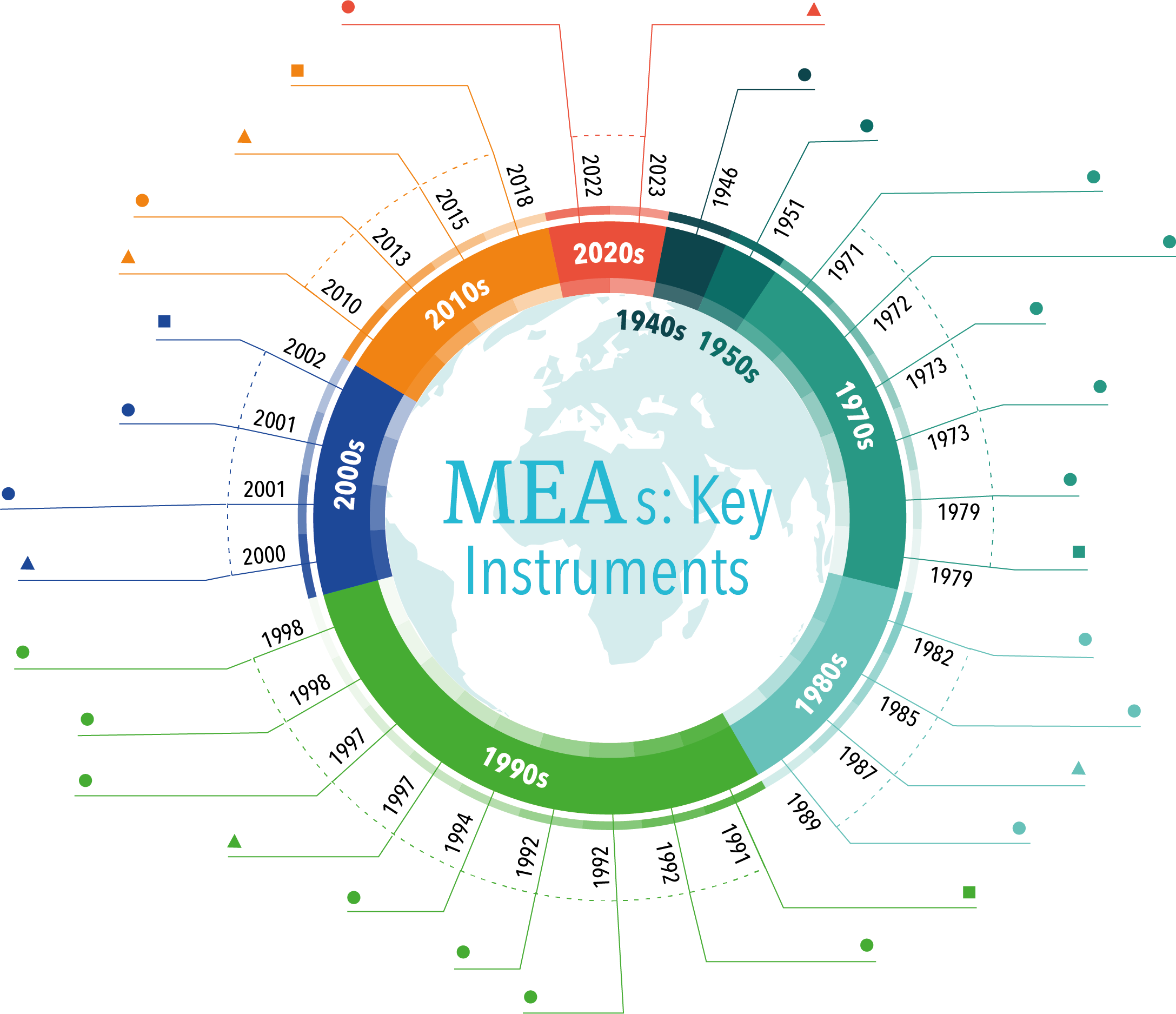

This infographic showcases Multilateral Environmental Agreements (MEAs) over time, by year of adoption.
You can hover over the name of an MEA to learn more about it and see any protocols. Click to visit the webpage.
You can hover over the name of an MEA to learn more about it and see any protocols. Click to visit the webpage.
International Convention for the Regulation of Whaling (ICRW)
The International Convention for the Regulation of Whaling was signed in 1946 and it is the International Whaling Commission’s founding document. The Convention includes a legally binding Schedule which, amongst other things, sets out catch limits for commercial and aboriginal subsistence whaling. The Schedule is an integral part of the Convention, but its provisions, for example catch limits, may be amended by the Commission. In practice, amendments to the Schedule are almost always agreed at the Commission’s biennial meetings.
International Plant Protection Convention (IPPC)
The International Plant Protection Convention (IPPC) is the intergovernmental treaty that aims to protect the world's plants, agricultural products and natural resources from plant pests. The IPPC develops, adopts and promotes the application of International Phytosanitary Measures (ISPMs) as the main tool to safeguard global food security, facilitate safe trade and protect the environment.
Ramsar Convention on Wetlands of International Importance
The Convention on Wetlands is the intergovernmental treaty that provides the framework for the conservation and wise use of wetlands and their resources. The Convention was adopted in the Iranian city of Ramsar in 1971 and came into force in 1975. Since then, almost 90% of UN member states, from all the world’s geographic regions, have acceded to become “Contracting Parties”.
Convention Concerning the Protection of the World Cultural and Natural Heritage

The idea of creating an international movement for protecting heritage emerged after World War I. The 1972 World Heritage Convention developed from the merging of two separate movements: the first focusing on the preservation of cultural sites, and the other dealing with the conservation of nature. The Convention recognizes the way in which people interact with nature, and the fundamental need to preserve the balance between the two.
Convention on International Trade in Endangered Species of Wild Fauna and Flora (CITES)
At the time when the ideas for CITES were first formed, in the 1960s, international discussion of the regulation of wildlife trade for conservation purposes was something relatively new. With hindsight, the need for CITES is clear. Annually, international wildlife trade is estimated to be worth billions of dollars and to include hundreds of millions of plant and animal specimens. Because the trade in wild animals and plants crosses borders between countries, the effort to regulate it requires international cooperation to safeguard certain species from over-exploitation. CITES was conceived in the spirit of such cooperation. Today, it accords varying degrees of protection to more than 40,000 species of animals and plants, whether they are traded as live specimens, fur coats or dried herbs.
Agreements under CITES
Lusaka Agreement on Co-operative Enforcement Operations
International Convention for the Prevention of Pollution from Ships (MARPOL)

MARPOL is the main international convention covering prevention of pollution of the marine environment by ships from operational or accidental causes. The Convention was adopted in November 1973 at the International Maritime Organization. The Protocol of 1978 was adopted in response to a spate of tanker accidents in 1976-1977. As the 1973 MARPOL Convention had not yet entered into force, the 1978 MARPOL Protocol absorbed the parent Convention. The combined instrument entered into force in 1983. The Convention includes regulations aimed at preventing and minimizing pollution from ships - both accidental pollution and that from routine operations - and currently includes six technical Annexes. Special Areas with strict controls on operational discharges are included in most Annexes.
Convention on the Conservation of Migratory Species of Wild Animals (CMS)

CMS provides a global platform for the conservation and sustainable use of migratory animals and their habitats. CMS brings together the States through which migratory animals pass, the Range States, and lays the legal foundation for internationally coordinated conservation measures throughout a migratory range. As the only global convention specializing in the conservation of migratory species, their habitats and migration routes, CMS complements and co-operates with a number of other international organizations, NGOs and partners in the media as well as in the corporate sector.
Agreements under CMS
ACAP
ACCOBAMS
AEWA
ASCOBANS
EUROBATS
Gorilla Agreement
Wadden Sea Seals
UNECE Convention on Long-range Transboundary Air Pollution (LRTAP)
When scientists in the 1960s investigated the causes of the “acid rain” that was destroying forests, causing fish loss in lakes and putting entire ecosystems at risks in the Northern Hemisphere, they found that air pollutants, a significant part of which were emitted thousands of kilometres away, were the culprit. In order to solve this problem, 32 countries in the pan-European region decided to cooperate to reduce air pollution. In 1979, they signed the UNECE Convention on Long-range Transboundary Air Pollution, creating the first international treaty to deal with air pollution on a broad regional basis. The Convention entered into force in 1983, laying down the general principles of international cooperation for air pollution abatement and setting up an institutional framework which has since brought together research and policy. Over the years, the number of substances covered by the Convention and its protocols has been gradually extended, notably to ground-level ozone, persistent organic pollutants, heavy metals and particulate matter.
United Nations Convention on the Law of the Sea (UNCLOS)

In a process that spanned 15 years, what started as an exercise to regulate the seabed turned into a global diplomatic effort to regulate and write rules for all ocean areas, all uses of the seas and all of its resources. These were some of the factors that led to the convening of the Third United Nations Conference on the Law of the Sea, to write a comprehensive treaty for the oceans. The Conference was convened in New York in 1973. It ended nine years later with the adoption in 1982 of a constitution for the seas - the United Nations Convention on the Law of the Sea.
Agreements under UNCLOS
United Nations Fish Stocks Agreement
BBNJ Agreement
Agreement relating to the implementation of Part XI
Vienna Convention for the Protection of the Ozone Layer

By 1985, the globe had already seen advancements in the scientific understanding of ozone depletion and its impacts on human health and the environment. It was then that the Vienna Convention for the Protection of the Ozone Layer was created in response. This agreement is a framework convention that lays out principles agreed upon by many parties. It does not, however, require countries to take control actions to protect the ozone layer. This would come later in the form of the Montreal Protocol. The Vienna Convention was the first convention of any kind to be signed by every country involved, taking effect in 1988 and reaching universal ratification in 2009. This speaks to the enormity of ozone depletion at the time and the willingness of countries around the world to work together to solve it.
Protocols under Vienna Convention
Montreal Protocol
Montreal Protocol on Substances that Deplete the Ozone Layer

The Montreal Protocol on Substances that Deplete the Ozone Layer is a global agreement to protect the Earth’s ozone layer by phasing out the chemicals that deplete it. This phase-out plan includes both the production and consumption of ozone-depleting substances. The landmark agreement was signed in 1987 and entered into force in 1989. The Montreal Protocol provided a set of practical, actionable tasks that were universally agreed on. The Protocol has successfully met its objectives thus far and continues to safeguard the ozone layer today. Thanks to the collaborative effort of nations around the world, the ozone layer is well on its way to recovery.
Basel Convention on the Control of Transboundary Movements of Hazardous Wastes and Their Disposal

The Basel Convention was adopted in March 1989, in response to a public outcry following the discovery, in the 1980s, in Africa and other parts of the developing world of deposits of toxic wastes imported from abroad. Awakening environmental awareness and corresponding tightening of environmental regulations in the industrialized world in the 1970s and 1980s had led to increasing public resistance to the disposal of hazardous wastes – in accordance with what became known as the NIMBY (Not In My Back Yard) syndrome – and to an escalation of disposal costs. This in turn led some operators to seek cheap disposal options for hazardous wastes in Eastern Europe and the developing world, where environmental awareness was much less developed and regulations and enforcement mechanisms were lacking. It was against this background that the Basel Convention was negotiated in the late 1980s, and its thrust at the time of its adoption was to combat the “toxic trade”, as it was termed. The Convention entered into force in 1992.
Protocols under Basel Convention
Basel Protocol on Liability and Compensation
Bamako Convention on Hazardous Wastes

The Bamako Convention is a treaty of African nations prohibiting the import into Africa of any hazardous (including radioactive) waste. The convention came into force in 1998. The Convention is a response to Article 11 of the Basel Convention, which encourages parties to enter into bilateral, multilateral and regional agreements on Hazardous Waste to help achieve the objectives of the convention. The impetus for the Bamako convention arose also from: The failure of the Basel Convention to prohibit trade of hazardous waste to less developed countries (LDCs); The realization that many developed nations were exporting toxic wastes to Africa (Koko case in Nigeria, Probo Koala case in Ivory Coast).
UNECE Convention on the Protection and Use of Transboundary Watercourses and International Lakes
The Water Convention was adopted in Helsinki in 1992 and entered into force in 1996. The Convention is a unique legally binding instrument promoting the sustainable management of shared water resources, the implementation of the Sustainable Development Goals, the prevention of conflicts, and the promotion of peace and regional integration. The Convention requires Parties to prevent, control and reduce transboundary impact, use transboundary waters in a reasonable and equitable way and ensure their sustainable management.
Protocols under Water Convention
Protocol on Water and Health
United Nations Framework Convention on Climate Change (UNFCCC)

The UNFCCC entered into force on 21 March 1994. Today, it has near-universal membership. In 1994, when the UNFCCC took effect, there was less scientific evidence than there is now. The UNFCCC borrowed a very important line from one of the most successful multilateral environmental treaties in history (the Montreal Protocol, in 1987): it bound member states to act in the interests of human safety even in the face of scientific uncertainty. The ultimate objective of the Convention is to stabilize greenhouse gas concentrations "at a level that would prevent dangerous anthropogenic (human induced) interference with the climate system."
Protocols/Agreements under UNFCCC
Kyoto Protocol
Paris Agreement
Convention on Biological Diversity (CBD)

The Earth's biological resources are vital to humanity's economic and social development. As a result, there is a growing recognition that biological diversity is a global asset of tremendous value to present and future generations. At the same time, the threat to species and ecosystems has never been so great as it is today. Species extinction caused by human activities continues at an alarming rate. In response, UNEP convened the Ad Hoc Working Group of Experts on Biological Diversity in November 1988 to explore the need for an international convention on biological diversity. Its work culminated on 22 May 1992 with the Nairobi Conference for the Adoption of the Agreed Text of the Convention on Biological Diversity.
Protocols under CBD
Cartagena Protocol
Nagoya Protocol
United Nations Convention to Combat Desertification (UNCCD)

When land is degraded or plagued by drought, it loses its capacity to sustain life, which leads to a range of consequences from crop failure to migration and conflict. The UNCCD was established in 1994 to protect and restore our land and ensure a safer, just, and more sustainable future. It is the only legally binding framework set up to address desertification and the effects of drought. There are 197 Parties to the Convention. The Convention – based on the principles of participation, partnership and decentralization – is a multilateral commitment to mitigate the impact of land degradation, and protect our land so we can provide food, water, shelter and economic opportunity to all people.
Kyoto Protocol

The Kyoto Protocol was adopted on 11 December 1997. Owing to a complex ratification process, it entered into force on 16 February 2005. In short, the Kyoto Protocol operationalizes the UNFCCC by committing industrialized countries and economies in transition to limit and reduce greenhouse gases (GHG) emissions in accordance with agreed individual targets. The Convention itself only asks those countries to adopt policies and measures on mitigation and to report periodically. The Kyoto Protocol is based on the principles and provisions of the Convention and follows its annex-based structure. It only binds developed countries, and places a heavier burden on them under the principle of “common but differentiated responsibility and respective capabilities”, because it recognizes that they are largely responsible for the current high levels of GHG emissions in the atmosphere.
United Nations Watercourses Convention
In 1997, more than 100 nations gathered to adopt the UN Watercourses Convention – a flexible and overarching global legal framework that establishes basic standards and rules for cooperation between watercourse states on the use, management, and protection of international watercourses. The Watercourses Convention is the only treaty governing shared freshwater resources that is of universal applicability. It is a framework convention, in the sense that it provides a framework of principles and rules that may be applied and adjusted to suit the characteristics of particular international watercourses.
UNECE Convention on Access to Information, Public Participation, and Access to Justice in Environmental Matters
The Aarhus Convention was adopted in June 1998 in the Danish city of Aarhus at the Fourth Ministerial Conference in the "Environment for Europe" process. Together with its Protocol on Pollutant Release and Transfer Registers, it protects every person’s right to live in an environment adequate to his or her health and well-being. They are the only global legally binding global instruments on environmental democracy that put Principle 10 of the Rio Declaration on Environment and Development in practice. The Aarhus Convention is a new kind of environmental agreement.
Protocols under Aarhus Convention
Kyiv Protocol on Pollutant Release and Transfer Registers
Rotterdam Convention on the Prior Informed Consent Procedure for Certain Hazardous Chemicals and Pesticides in International Trade

The dramatic growth in chemical production and trade during the past three decades has raised concerns about the potential risks posed by hazardous chemicals and pesticides. Countries lacking adequate infrastructure to monitor the import and use of these chemicals are particularly vulnerable. The Rotterdam Convention was adopted in 1998, with the objectives to promote shared responsibility and cooperative efforts among Parties in the international trade of certain hazardous chemicals, and to contribute to the environmentally sound use of those hazardous chemicals. The Convention creates legally binding obligations for the implementation of the Prior Informed Consent (PIC) procedure. It built on the voluntary PIC procedure, initiated by UNEP and FAO in 1989.
Cartagena Protocol on Biosafety to the Convention on Biological Diversity

The Cartagena Protocol is an international treaty governing the movements of living modified organisms (LMOs) resulting from modern biotechnology from one country to another. It was adopted on in January 2000 as a supplementary agreement to the Convention on Biological Diversity and entered into force in September 2003.
Stockholm Convention on Persistent Organic Pollutants

The Stockholm Convention is a global treaty to protect human health and the environment from chemicals that remain intact in the environment for long periods, become widely distributed geographically, accumulate in the fatty tissue of humans and wildlife, and have harmful impacts on human health or on the environment. Exposure to Persistent Organic Pollutants (POPs) can lead to serious health effects including certain cancers, birth defects, dysfunctional immune and reproductive systems, greater susceptibility to disease and damages to the central and peripheral nervous systems. Given their long range transport, no one government acting alone can protect its citizens or its environment from POPs. In response to this global problem, the Stockholm Convention, which was adopted in 2001 and entered into force in 2004, requires its parties to take measures to eliminate or reduce the release of POPs into the environment.
International Treaty on Plant Genetic Resources for Food and Agriculture (ITPGRFA)

The conservation and sustainable use of plant genetic resources for food and agriculture are key to ensuring that the world will produce enough food to feed its growing population in the future. In 1983, the Commission on Genetic Resources for Food and Agriculture was established, and the voluntary International Undertaking on Plant Genetic Resources was adopted. Another major step was taken in 1996 with the adoption of the Global Plan of Action at the Leipzig International Technical Conference on Plant Genetic Resources. All this work culminated in 2001 with the historic adoption of the legally binding ITPGRFA. The Treaty aims at recognizing the enormous contribution of farmers to the diversity of crops that feed the world; establishing a global system to provide farmers, plant breeders and scientists with access to plant genetic materials; ensuring that recipients share benefits they derive from the use of these genetic materials.
ASEAN Agreement on Transboundary Haze Pollution (AATHP)

Following severe land and forest fires in 1997-1998, ASEAN Member States signed the ASEAN Agreement on Transboundary Haze Pollution (AATHP) on 10 June 2002 in Kuala Lumpur, Malaysia, to prevent, monitor, and mitigate land and forest fires to control transboundary haze pollution through concerted national efforts, regional and international cooperation. The Agreement entered into force in 2003 and has been ratified by all ASEAN Member States.
Nagoya Protocol on Access to Generic Resources and the Fair and Equitable Sharing of Benefits Arising from their Utilization

The Nagoya Protocol is a supplementary agreement to the Convention on Biological Diversity. It provides a transparent legal framework for the effective implementation of one of the three objectives of the CBD: the fair and equitable sharing of benefits arising out of the utilization of genetic resources. The Nagoya Protocol on ABS was adopted in October 2010 in Nagoya, Japan and entered into force in October 2014, 90 days after the deposit of the fiftieth instrument of ratification.
Protocols under Nagoya Protocol
Nagoya-Kuala Lumpur Supplementary Protocol on Liability and Redress
Minamata Convention on Mercury

The Minamata Convention draws attention to a global and ubiquitous metal that, while naturally occurring, has broad uses in everyday objects and is released to the atmosphere, soil and water from a variety of sources. Controlling the anthropogenic releases of mercury throughout its lifecycle has been a key factor in shaping the obligations under the Convention. Major highlights of the Minamata Convention include a ban on new mercury mines, the phase-out of existing ones, the phase-out and phase-down of mercury use in a number of products and processes, control measures on emissions to air and on releases to land and water, and the regulation of the informal sector of artisanal and small-scale gold mining. The Convention also addresses interim storage of mercury and its disposal once it becomes waste, sites contaminated by mercury as well as health issues.
Paris Agreement

The Paris Agreement is a legally binding international treaty on climate change. It was adopted by 196 Parties at the UN Climate Change Conference (COP21) in Paris, France, on 12 December 2015. It entered into force on 4 November 2016. Its overarching goal is to hold “the increase in the global average temperature to well below 2°C above pre-industrial levels” and pursue efforts “to limit the temperature increase to 1.5°C above pre-industrial levels.” The Paris Agreement is a landmark in the multilateral climate change process because, for the first time, a binding agreement brings all nations together to combat climate change and adapt to its effects.
Regional Agreement on Access to Information, Public Participation and Justice in Environmental Matters in Latin America and the Caribbean

Adopted at Escazú, Costa Rica, on 4 March 2018, the Escazú Agreement has as its objective to guarantee the full and effective implementation in Latin America and the Caribbean of the rights of access to environmental information, public participation in the environmental decision-making process and access to justice in environmental matters, and the creation and strengthening of capacities and cooperation, contributing to the protection of the right of every person of present and future generations to live in a healthy environment and to sustainable development. It is the only binding agreement stemming from the United Nations Conference on Sustainable Development (Rio+20), the first regional environmental agreement of Latin America and the Caribbean and the first in the world containing specific provisions on environmental human rights defenders.
Intergovernmental Negotiating Committee on Plastic Pollution
In March 2022, at the resumed fifth session of the UN Environment Assembly (UNEA-5.2), a historic resolution was adopted to develop an international legally binding instrument on plastic pollution, including in the marine environment. The resolution (5/14) requested the Executive Director of the UN Environment Programme (UNEP) to convene an Intergovernmental Negotiating Committee (INC) to develop "the instrument," which is to be based on a comprehensive approach that addresses the full life cycle of plastic, including its production, design, and disposal. The INC began its work during the second half of 2022, with the ambition to complete the negotiations by the end of 2024.
Agreement under the United Nations Convention on the Law of the Sea on the Conservation and Sustainable Use of Marine Biological Diversity of Areas Beyond National Jurisdiction (BBNJ Agreement)

The BBNJ Agreement was adopted on 19 June 2023 by the Intergovernmental Conference on Marine Biodiversity of Areas Beyond National Jurisdiction convened under the auspices of the United Nations. The BBNJ Agreement becomes the third implementing agreement to UNCLOS. Under the overall objective of the conservation and sustainable use of marine biological diversity of areas beyond national jurisdiction, the BBNJ Agreement addresses four main issues: Marine genetic resources, including the fair and equitable sharing of benefits; Measures such as area-based management tools, including marine protected areas; Environmental impact assessments; and Capacity-building and the transfer of marine technology.